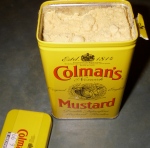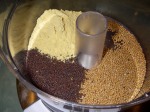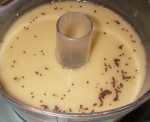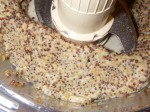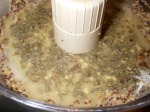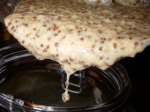Making mustard isn’t baking, but I’ve just learned how to do it, and it can be used on baked goods, like bread or pork pie. Now I just have to learn to make pork pie.
There are two basic recipes. One uses mustard seeds and mustard powder, and the other just uses mustard powder. The common mustard powder is Colman’s, which is an English product that’s available in many grocery stores in North America.
You can put together a small batch of mustard and store it in the refrigerator for a few weeks. If you want it to keep longer than that, or if you want to be able to give it as a handmade gift, you have to can it, which involves having canning jars with proper lids, sterilizing the jars and lids, and heating the mustard to 135℉ before you put it in the sterilized jars. I might actually do this for holiday gifts; we’ll see.
I got my tin of Colman’s at the Harvest Co-op in Central Square, Cambridge, and my mustard seeds (some yellow and some brown) from the bulk jars there. The Colman’s was $7 for 4 ounces, and the mustard seeds were $5.39 a pound or $6.49 a pound, depending on the variety, and I got about half a pound of each, which brings my investment in mustard-only ingredients to about $13. This will make plenty of mustard, but obviously you don’t make your own mustard unless you really love mustard and want to be creative with it.
I’m pretty much following the recipe from Maggie Oster’s Herbal Vinegar. Here’s her list of ingredients for 2 cups of mustard:
½ cup light or dark mustard seeds
¼ cup dry English mustard
¾ cup herb or other flavored vinegar
⅔ cup water, wine, beer, or fruit juice
¼ cup fresh herbs, minced; or 2 Tablespoons herb seeds, ground
2 Tablespoons honey or 3 Tablespoons white or packed brown sugar
1 teaspoon salt
Here’s my list of ingredients, which, except for the mustard ingredients, I already had in my pantry:
1½ oz (¼ cup) yellow mustard seeds
1½ oz (scant ¼ cup) brown mustard seeds (these are smaller than the yellow ones, so they pack tighter)
¾ oz (¼ cup) Colman’s mustard powder
6 oz (¾ cup) white wine vinegar
4¾ oz (⅔ cup) Noilly Prat dry vermouth
2 tsp dried tarragon (the one that keeps coming up in mustard recipes)
1 oz (2 Tbl) clover honey
2 tsp Diamond Crystal kosher salt
Combine the mustard seeds, mustard powder, vinegar, and vermouth in a measuring pitcher or other nonreactive container.
Let the mixture sit for 4 hours, uncovered, stirring occasionally. You can let it sit as little as 2 hours or as long as overnight, if that’s more convenient.
Maggie wants you to add the remaining ingredients and process the mixture until it’s the consistency you like. Unfortunately, the seeds just whir around in the liquid and don’t get ground at all. You need to strain off the liquid first. Just pouring off the liquid wasn’t enough:
I had to pour the mixture through a strainer and then return the seed glop to the workbowl. It took awhile to get the seeds ground into anything resembling paste, but that’s because my food processor’s blade is dull. If you have a good sharp blade, this should take a minute or two. If you want to get a good look at the progress, stop the machine and take off the lid. I made the mistake of lifting the pusher out of the feed tube and looking in through there, and the fumes nearly blinded me.
When the consistency looks like what you want, add the herbs and salt:
I stirred the honey into the liquid ingredients and poured that into the workbowl and let ‘er rip. After a few more minutes (less if your blade is sharp), I thought I had mustard.
This is a little runny. For stiffer mustard, you can use sugar instead of honey, and you can grind the seeds more.
Taste the mustard to see how hot it is; it will be hot. If you like it that hot, put it in a container and store it in the fridge. If you’d like it to mellow a bit, leave the container at room temperature. When the mustard mellows to your preferred level of heat, store it in the fridge. According to a helpful FAQ, once the mustard is chilled, the level of heat is set. Dr. Science is skeptical. I have some mustard that I made in a class and stored in the fridge as soon as I got it home. He proposes to experiment by keeping some in the fridge and some on the counter and tasting them both (at room temperature) at intervals to see if the one on the counter retains its heat or mellows.
This is obviously grainy mustard. If you want smooth mustard, Maggie’s ingredients are:
1 cup dry English mustard
1 cup herb or other flavored vinegar
3 Tbl water, wine, beer, or fruit juice
1/4 cup fresh herbs, minced
2 Tbl honey or 3 Tbl white or packed brown sugar
1 tsp salt
You’ll need a bigger tin of mustard powder, or you’ll have to make a smaller batch. The procedure is the same, except you skip the part about grinding the seeds, obviously.
Reference
Maggie Oster: Herbal Vinegar. Pownal, Vermont: Storey Publishing, 1994, p 113.

